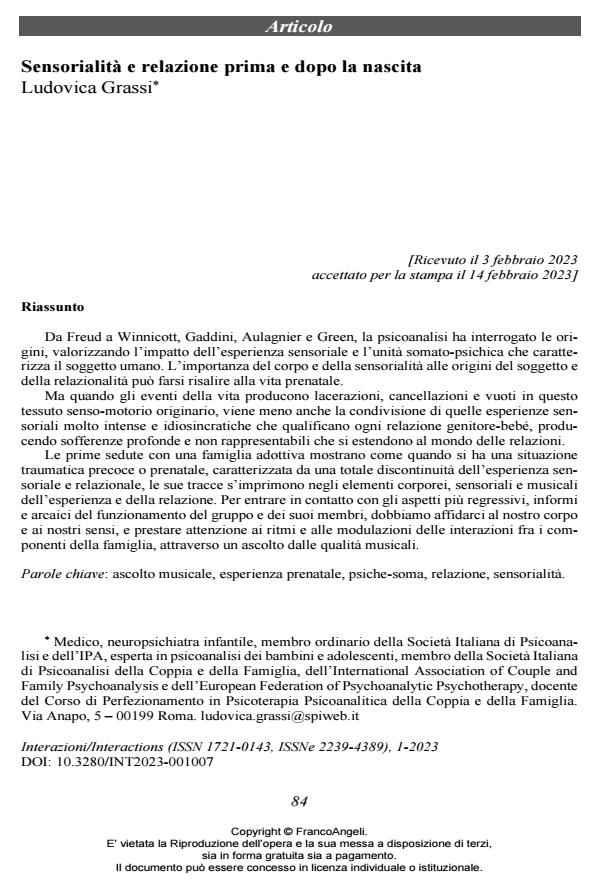Sensoriality and relationship before and after birth
Journal title INTERAZIONI
Author/s Ludovica Grassi
Publishing Year 2023 Issue 2023/1 Language Italian
Pages 15 P. 84-98 File size 190 KB
DOI 10.3280/INT2023-001007
DOI is like a bar code for intellectual property: to have more infomation
click here
Below, you can see the article first page
If you want to buy this article in PDF format, you can do it, following the instructions to buy download credits

FrancoAngeli is member of Publishers International Linking Association, Inc (PILA), a not-for-profit association which run the CrossRef service enabling links to and from online scholarly content.
From Freud to Winnicott, Gaddini, Aulagnier and Green, psychoanalysis has questioned the origins, emphasising the impact of sensory experience and the somato-psychic unity that characterises the human subject. The importance of the body and sensoriality at the origins of the subject and relationality can be traced back to prenatal life. When life events produce lacerations, cancellations and voids in this original sense-motor fabric, the sharing of those very intense and idiosyncratic sensorial experiences that qualify every parent-baby relationship also fails, producing deep and unrepresentable suffering that extends to the world of relationships. The first sessions with an adoptive family show that, when there is an early or prenatal traumatic situation, characterised by a total discontinuity of the sensorial and relational experi-ence, its traces are imprinted in the bodily, sensorial and musical elements of the experience and relationship. In order to get in touch with the most regressive, formless and archaic as-pects of the functioning of the group and its members, we must rely on our bodies and senses. More specifically, a musical listening can enable us to gather the rhythms and modulations of the interactions between family members.
Keywords: musical listening, prenatal experience, psyche-soma, relationship, sensoriality
- Ajuriaguerra J. de (1970). Manuel de psychiatrie de l’enfant. Paris: Masson, 1970.
- Anzieu D. (1985). L’Io-pelle. Roma: Borla, 1987.
- Aulagnier P. (1975). La violenza dell’interpretazione. Roma: Borla, 2005.
- Aulagnier P. (2015). Birth of a body, origin of a history. International Journal of Psycho-Analysis, 96, 5: 1371-1401. DOI: 10.1111/1745-8315.1234
- Bion W.R. (1957). Differentiation of the psychotic from the non-psychotic personalities. International Journal of Psycho-Analysis, 38: 266-275.
- Bion W.R. (1977). Two papers: The grid and caesura. New York: Routledge, 2018.
- Brandt P.A. (2009). Music and how we become human-a view from cognitive semiotics. Exploring imaginative hypotheses. In Malloch S., Trevarthen C. (Eds.), Communicative musicality: exploring the basis of human companionship. Oxford: Oxford University Press.
- Fornari F. (1984). Psicoanalisi della musica. Milano: Longanesi.
- Gaddini E. (1968). Sulla imitazione. Rivista di Psicoanalisi, 14, 3: 235-260.
- Gaddini E. (1980). Note sul problema mente-corpo. In Gaddini E., Scritti. 1953-1985. Milano: Cortina, 2002.
- Grassi L. (2012). L’originario ha qualcosa a che fare con le origini? Interazioni, 35, 1: 69-86. DOI: 10.3280/INT2012-00100
- Grassi L. (2021). The sound of the unconscious. Psychoanalysis as music. London: Routledge [Trad. it. L’inconscio sonoro: Psicoanalisi in musica. Milano: FrancoAngeli, 2022].
- Green A. (1982). A posteriori, l’arcaico. In Green A., Psicoanalisi degli stati limite. La follia privata. Milano: Raffaello Cortina, 1991.
- Green A. (1998). The primordial mind and the work of the negative. International Journal of Psycho-Analysis, 79: 649-665.
- Lacan J. (1966). Lo stadio dello specchio come formatore della funzione dell’Io. In Lacan J., Scritti. Torino: Einaudi, 2002.
- Maiello S. (1993). L’oggetto sonoro. Richard e Piggle – Studi psicoanalitici del bambino e dell’adolescente, 1, 1: 32-47.
- Salomonsson B. (2011). La musica del contenimento. Come e quando rivolgersi ai membri della diade madre-lattante in trattamento psicoanalitico. Interazioni, 34, 2: 29-47. DOI: 10.3280/INT2011-00200
- Winnicott D.W. (1967). La funzione di specchio della madre e della famiglia nello sviluppo infantile. In Winnicott D.W., Psicoanalisi dello sviluppo. Roma: Armando, 2004.
- Winnicott D.W. (1970). Sulle basi di Sé nel corpo. In Winnicott D.W., Esplorazioni psicoanalitiche. Milano: Raffaello Cortina, 1995
Ludovica Grassi, Sensorialità e relazione prima e dopo la nascita in "INTERAZIONI" 1/2023, pp 84-98, DOI: 10.3280/INT2023-001007